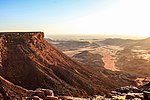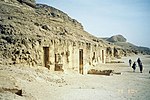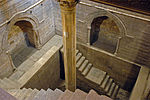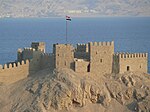ویکیپدیا:ویکیپروژه میراث جهانی/مصر
ظاهر
| ردیف | صفحه | تعداد میانویکیها | حجم صفحه | فضای نام صفحه | کاربر سازنده |
|---|---|---|---|---|---|
| ۱ | قاهره اسلامی | ۳۱ | ۳۵۹۸۷ | ۰ | |
| ۲ | en:Theban_Necropolis | ۲۷ | ۳۵۷۶ | ۰ | |
| ۳ | فهرست میراث جهانی یونسکو در مصر | ۲۱ | ۱۰۸۹۸ | ۰ | |
| ۴ | en:Old_Cairo | ۱۶ | ۷۳۷۰ | ۰ | |
| ۵ | en:Bigeh | ۸ | ۴۰۰۳ | ۰ | |
| ۶ | en::Category:Assiut | ۶ | ۴۱۳ | ۱۴ | |
| ۷ | قلعه النخل | ۲ | ۹۲۲۰ | ۰ |
- صفحههای موجود در ردهٔ World Heritage Sites in Egypt در ویکیپدیای انگلیسی که در ویکیپدیای فارسی موجود نیستند
- ۱۴ مورد از صفحههای موجود در ردهٔ انگلیسی در ویکیپدیای فارسی مقاله دارند.
- ۴ صفحهٔ زیر (مرتبشده بر اساس تعداد میانویکی) فاقد میانویکی فارسی هستند.
- Theban Necropolis (۳۶ میانویکی)
- Old Cairo (۲۱ میانویکی)
- Bigeh (۱۲ میانویکی)
- Philae temple complex (۸ میانویکی)
ازمایشی
[ویرایش]| Site | Image | Location (governorate) | Year listed | UNESCO criteria | Description |
|---|---|---|---|---|---|
| سیوه | 
|
استان مطروح | 1994 | (cultural) | Siwa Oasis contains several archaeological sites, including the وخشور of آمون.[۱] |
| سرابیط الخادم | 
|
استان سینای جنوبی | 1994 | (cultural) | This nomination comprises the Temple of Serabit Khadem and دیر کاترین مقدس. The latter was listed as a World Heritage Site in 2002.[۲] |
| North Sinai Archaeological Sites Zone | استان سینای شمالی | 1994 | (cultural) | The land bridge between Egypt and کنعان has been an important route for military expeditions in both directions through history. It comprises a collection of ancient sites between the کانال سوئز and نوار غزه along the دریای مدیترانه coast.[۳] | |
| Temple of Hator built by Ramses III | 1994 | (cultural) | No information provided in the nomination documentation.[۴] | ||
| دهشور | 
|
استان جیزه | 1994 | (cultural) | Dahshur was a part of the Memphite Necropolis that has been listed as a World Heritage Site since 1979. It was first used by سنفرو of the دودمان چهارم مصر, who constructed the هرم خمیده (pictured). It was later used by the pharaohs of the پادشاهی میانه مصر.[۵] |
| El Fayoum | 
|
استان فیوم | 1994 | (cultural) | This nomination comprises eight sites, including Kom Aushim (Karanis), Dimai (Soknopaiou Nesos, pictured), Qasr Qarun (Dionysias), Batn I hrit (Theadelphia), and Byahma-فیوم.[۶] |
| El-Gendi Fortress | استان سینای جنوبی | 1994 | (cultural) | The fortress was constructed under صلاحالدین ایوبی in 1183 on a mountain at a height of ۲٬۱۵۰ متر (۷٬۰۵۰ فوت). It has several towers, two mosques, and rooms for soldiers.[۷] | |
| الطور (مصر) | استان سینای جنوبی | 1994 | (cultural) | Rutho Monastery was constructed in the 6th century. Its ruins were discovered in 1984. The complex contained two basilicas, an oil press, and rooms for monks. It was surrounded by defensive walls.[۸] | |
| Wadi Feiran | استان سینای جنوبی | 1994 | (cultural) | The Feiran Oasis has remains of old monasteries and churches, as well as rocks with نبطیها inscriptions.[۹] | |
| جزیره فرعون | 
|
استان سینای جنوبی | 1994 | (cultural) | The island is situated on a strategic location in the خلیج عقبه. It has structures from different periods, including a fortress built under صلاحالدین ایوبی to protect the trade routes.[۱۰] |
| دهب | استان سینای جنوبی | 1994 | (cultural) | In Dahab, there are remains of a امپراتوری بیزانس lighthouse and remains of a settlement from the 5th and 6th centuries.[۱۱] | |
| منیا | 
|
استان منیا | 1994 | (cultural) | This nomination comprises the tombs of Beni Hasan, tombs of عمارنه (مصر), الاشمونین, and Tuna El-Gebel sites (pictured).[۱۲] |
| نویبع | استان سینای جنوبی | 1994 | (cultural) | The castle from 1893 was constructed on the site of an older castle from the ایوبیان period.[۱۳] | |
| Ras Mohammed | 
|
استان سینای جنوبی | 2002 | vii, viii, ix, x (natural) | The area comprises desert on land and a marine habitat with صخرههای مرجانیs rich in animal species. There are also sites with fossil corals.[۱۴] |
| دریاچه قارون | 
|
استان فیوم | 2003 | (mixed) | The معدن سنگ around Lake Qaroun (on the site of the ancient Lake Moeris) were already in use in the Predynastic period (4th millennium BCE) and stone from here was used in temples of the پادشاهی کهن مصر. Excavations have also uncovered دوران نوسنگی stone tools and remains of an ancient فیلسانانn, فیلسان قارون.[۱۵] |
| Southern and Smaller Oases, the Western Desert | 
|
استان بحیره, استان مطروح, استان وادیالجدید | 2003 | vii, viii, ix, x (natural) | This nomination comprises five sites in the Western Desert: خارجه, Dakhla Oasis (pictured), Moghra Oasis, Dunqul Oasis, and the دره ناترون فرورفتگی. These sites have been inhabited since ancient times. People grow خرماs, olives, fruit trees, as well as some cereals. There are several خشکیرست and گیاهان شورپسند plant species. The area is also home to the آهوی گرمسیری.[۱۶] |
| Bird Migration Routes | 
|
استان اسوان, استان سینای شمالی, استان بحرالاحمر | 2003 | vii, x (natural) | This nomination comprises five sites: Lake Bardawil (pictured) and Zaranik on the دریای مدیترانه coast, the شایبالبنات area on the دریای سرخ coast, and Saluga and Ghazal Islands and the دریاچه ناصر on the نیل. These sites are important stopovers for migratory birds, as well as for the resident ones.[۱۷] |
| Desert Wadis | 
|
استان اسوان, استان بحرالاحمر | 2003 | vii, viii, ix, x (natural) | This nomination comprises three desert خشکرود (وادی)s: Wadi Allaqi, Wadi El Gemal, and Wadi Qena. They were river valleys during the دوره پربارش نوسنگی. They are nominated due to historical remains spanning from prehistory to مصر (استان روم), as well as biodiversity. El Gemal (pictured) is located at the دریای سرخ coast and is an important stopover for migratory birds, a nesting site for لاکپشت سبز دریاییs, and a habitat for فیل دریاییs.[۱۸] |
| Mountain Chains | 
|
استان اسوان, استان وادیالجدید, استان بحرالاحمر | 2003 | vii, viii, ix, x (natural) | This nomination comprises five areas with mountain chains that reach at some points above ۲٬۰۰۰ متر (۶٬۶۰۰ فوت). They are nominated due to the geological formations they exhibit, their plant and animal life, and some sites have prehistoric سنگنگارهs. Gilf Kebir is pictured.[۱۹] |
| Great Desert Landscapes | 
|
استان بنیسویف, استان مطروح | 2003 | vii, viii, ix (natural) | This nomination comprises three sites: the فرورفتگی قطاره, a فرورفتگی with various geomorphological land formations, the دریای ماسهای بزرگ (pictured), which is a vast expanse of sandy dunes, and the Sannur Cave area, where مرمر گچی was mined in ancient times.[۲۰] |
| اسکندریه, ancient remains and the new library | 
|
استان اسکندریه | 2003 | i, ii, vi (cultural) | Alexandria was founded in 332 BCE by اسکندر مقدونی and was an important centre of arts and learning in اروپای دوران باستان, with famous structures such as the فانوس اسکندریه and the کتابخانه اسکندریه. The existing monuments include ستون السواری (pictured), سراپئوم اسکندریه, several tombs, and underwater remains. A کتابخانه جدید اسکندریه was inaugurated in 2002.[۲۱] |
| ابیدوس, city of pilgrimage of the Pharaohs | 
|
استان سوهاج | 2003 | iv, vi (cultural) | Abydos was declared the city of ازیریس, god of the afterlife, under اینتف دوم of the دودمان یازدهم مصر. Due to its significance as a cult site, numerous pharaohs visited the city and constructed temples there, including ستی یکم and رامسس دوم (temple pictured). There are شهر مردگانes from various periods around the city.[۲۲] |
| Pharaonic temples in Upper Egypt from the Ptolemaic and Roman periods | 
|
استان اسوان, استان اقصر, استان قنا | 2003 | iv (cultural) | This nomination comprises four temples that were built in the امپراتوری بطلمیوسی and مصر (استان روم) periods, with some incorporating components of earlier structures. The temples are the معبد دندره المرکب (Temple of Hathor pictured), معبد کوم امبو, Khnum Temple in اسنا, and the معبد حوروس در ادفو.[۲۳] |
| Necropolises of Middle Egypt, from the Middle Empire to the Roman period | 
|
استان منیا | 2003 | ii, iii, vi (cultural) | This nomination comprises the tombs of Beni Hasan (pictured), tombs of عمارنه (مصر), الاشمونین, and Tuna El-Gebel sites. They date from the پادشاهی میانه مصر to the مصر (استان روم). Many tombs are decorated with paintings, carvings, and statues.[۲۴] |
| Raoudha nilometre in Cairo | 
|
استان قاهره | 2003 | i, iv (cultural) | A nilometer was a structure for measuring the نیل River's clarity and water level during the annual flood season. The structure on Roda Island dates to the early 8th century and was renovated several times. It has a three-storey well and a marble pillar to monitor the water level.[۲۵] |
| The monasteries of the Arab Desert and Wadi Natrun | 
|
استان بحیره, استان سوئز | 2003 | ii, iv, v (cultural) | This nomination comprises two groups of کلیسای ارتدکس قبطی monasteries, one group in دره ناترون and the other in the صحرای شرقی. The oldest one is the صومعه سنت آنتونی, associated with the monk آنتونی بزرگ, one of the founders of رهبانیت مسیحی at the end of the 3rd century. Other monasteries include those of Saint Paul the Anchorite, Saint Pishoy, Saint Macarius the Great, and Saint Mary Deipara (pictured).[۲۶] |
| Two citadels in Sinai from the Saladin period (Al-Gundi and Pharaoh's island) | 
|
استان سینای جنوبی | 2003 | iv, vi (cultural) | The two fortresses, one in Al-Gundi and the other one on the جزیره فرعون (pictured), were constructed in the 12th century under صلاحالدین ایوبی. They were strategic forts during the جنگهای صلیبی but lost importance after 1291. Parts of the forts have been well preserved.[۲۷] |
| The قلعه النخل, a stage on the pilgrimage route to Mecca | 
|
استان سینای شمالی | 2003 | iii, iv, vi (cultural) | The fortress was constructed under قانصوه غوری in the early 16th century and it was used until the end of the 19th century. It was used as a stopover for pilgrims undertaking حج on the way to مکه. It provided the pilgrims a place to rest, food, and drinking water.[۲۸] |
| Oasis of Fayoum, hydraulic remains and ancient cultural landscapes | 
|
استان فیوم | 2003 | i, iv, v (cultural) | Faiyum Oasis has been inhabited since prehistoric times and was one of the first areas of Northern Egypt where agriculture was practiced. There used to be a large lake in the antiquity. Water management works in the area started under the دودمان دوازدهم مصر and the oasis saw the greatest prosperity in the Greco-Roman period when it was one of Egypt's richest agricultural areas.[۲۹] |
| Historic quarters and monuments of رشید (شهر) | 
|
استان بحیره | 2003 | ii, iv, v (cultural) | Located in the دلتای نیل, Rosetta was usually overshadowed by the bigger اسکندریه but it flourished following the جنگ عثمانی و مملوکان (۱۵۱۶–۱۵۱۷) in 1517. It again declined in the 19th century with the construction of کانال سوئز. There are some historical buildings in the city, as well as قلعه جولیان (walls pictured), built by Qaitbay in 1479, where the سنگ روزتا was discovered in 1799.[۳۰] |
| Dababiya | 
|
استان قنا | 2008 | viii (natural) | Dababiya is a geological site covering the period from upper پالئوسن to lower ائوسن, including the period around the بیشینه گرمایی پالئوسن-ائوسن. It covers layers of marine sediments with different species of روزندارانe. The نقطه و برش چینهگون مرزی جهانی point for the beginning of the ایپرزین stage is defined at Dababiya.[۳۱] |
| Helwan Observatory | 
|
استان حلوان | 2010 | ii, vi, vii (mixed) | The astronomical observatory at حلوان (مصر) (a historical photograph pictured) was constructed in 1903 to host a 30-inch تلسکوپ بازتابی, the first large telescope in Africa. It was used to study دنبالهدار هالی, galaxies, and, for religious purposes, the movements of the sun, the moon, and شباهنگ (ستاره).[۳۲] |
| خارجه and the Small Southern Oases | 
|
استان وادیالجدید | 2015 | i, ii, iii, iv, v, vii, viii, ix, x (mixed) | This site comprises the Kharga Oasis and two other sites, the Dungul & Kurkur and Nabta Playa. These sites have been inhabited since prehistory but the majority of archaeological sites are from the امپراتوری روم متأخر period. The remains include fortresses, a Christian cemetery of Bagawat (pictured), and irrigating systems with subterranean aqueducts. There are several خشکیرست and گیاهان شورپسند plant species. The area is also home to the آهوی گرمسیری. Parts of this nomination have already been nominated in 2003.[۳۳] |
| موزه مصر | 
|
استان قاهره | 2021 | iv, vi (cultural) | The museum was designed by the French architect Marcel Dourgnon as an entry to the 1895 competition to construct a museum to host the vast collection of antiquities. The معماری هنرهای زیبا building was the first purpose-built museum in the region and influenced the designs of other museums. Due to its collections, it is the centre of مصرشناسی.[۳۴] |
- ↑ "Siwa archaeological area" (به انگلیسی). UNESCO World Heritage Centre. Archived from the original on 13 January 2024. Retrieved 5 January 2024.
- ↑ "Temple of Serabit Khadem" (به انگلیسی). UNESCO World Heritage Centre. Archived from the original on 13 January 2024. Retrieved 5 January 2024.
- ↑ "North Sinai Archaeological Sites Zone" (به انگلیسی). UNESCO World Heritage Centre. Archived from the original on 13 January 2024. Retrieved 5 January 2024.
- ↑ "Temple of Hator built by Ramses III" (به انگلیسی). UNESCO World Heritage Centre. Archived from the original on 13 January 2024. Retrieved 5 January 2024.
- ↑ "Dahshour archaeological area" (به انگلیسی). UNESCO World Heritage Centre. Archived from the original on 13 January 2024. Retrieved 5 January 2024.
- ↑ "El Fayoum: Kom Aushim (Karanis), Dimai (Soknopaiounesos), Qasr Qarun (Dionysias), Batn I hrit (Theadelphia), Byahma-Medinet el Fayoum…." (به انگلیسی). UNESCO World Heritage Centre. Archived from the original on 13 January 2024. Retrieved 5 January 2024.
- ↑ "El-Gendi Fortress" (به انگلیسی). UNESCO World Heritage Centre. Archived from the original on 13 January 2024. Retrieved 5 January 2024.
- ↑ "Rutho Monastery" (به انگلیسی). UNESCO World Heritage Centre. Archived from the original on 3 March 2023. Retrieved 5 January 2024.
- ↑ "Wadi Feiran" (به انگلیسی). UNESCO World Heritage Centre. Archived from the original on 21 January 2024. Retrieved 5 January 2024.
- ↑ "Pharaon Island" (به انگلیسی). UNESCO World Heritage Centre. Archived from the original on 21 January 2024. Retrieved 5 January 2024.
- ↑ "Dahab" (به انگلیسی). UNESCO World Heritage Centre. Archived from the original on 13 January 2024. Retrieved 5 January 2024.
- ↑ "Minia" (به انگلیسی). UNESCO World Heritage Centre. Archived from the original on 13 January 2024. Retrieved 5 January 2024.
- ↑ "Newibah castle" (به انگلیسی). UNESCO World Heritage Centre. Archived from the original on 13 January 2024. Retrieved 5 January 2024.
- ↑ "Ras Mohammed" (به انگلیسی). UNESCO World Heritage Centre. Archived from the original on 13 January 2024. Retrieved 5 January 2024.
- ↑ "Gebel Qatrani Area, Lake Qaroun Nature Reserve" (به انگلیسی). UNESCO World Heritage Centre. Archived from the original on 13 January 2024. Retrieved 5 January 2024.
- ↑ "Southern and Smaller Oases, the Western Desert" (به انگلیسی). UNESCO World Heritage Centre. Archived from the original on 13 January 2024. Retrieved 5 January 2024.
- ↑ "Bird Migration Routes" (به انگلیسی). UNESCO World Heritage Centre. Archived from the original on 13 January 2024. Retrieved 5 January 2024.
- ↑ "Desert Wadis" (به انگلیسی). UNESCO World Heritage Centre. Archived from the original on 13 January 2024. Retrieved 5 January 2024.
- ↑ "Mountain Chains" (به انگلیسی). UNESCO World Heritage Centre. Archived from the original on 22 November 2023. Retrieved 5 January 2024.
- ↑ "Great Desert Landscapes" (به انگلیسی). UNESCO World Heritage Centre. Archived from the original on 13 January 2024. Retrieved 5 January 2024.
- ↑ "Alexandria, ancient remains and the new library" (به انگلیسی). UNESCO World Heritage Centre. Archived from the original on 13 January 2024. Retrieved 5 January 2024.
- ↑ "Abydos, city of pilgrimage of the Pharaohs" (به انگلیسی). UNESCO World Heritage Centre. Archived from the original on 13 January 2024. Retrieved 5 January 2024.
- ↑ "Pharaonic temples in Upper Egypt from the Ptolemaic and Roman periods" (به انگلیسی). UNESCO World Heritage Centre. Archived from the original on 13 January 2024. Retrieved 5 January 2024.
- ↑ "Necropolises of Middle Egypt, from the Middle Empire to the Roman period" (به انگلیسی). UNESCO World Heritage Centre. Archived from the original on 13 January 2024. Retrieved 5 January 2024.
- ↑ "Raoudha nilometre in Cairo" (به انگلیسی). UNESCO World Heritage Centre. Archived from the original on 13 January 2024. Retrieved 5 January 2024.
- ↑ "The monasteries of the Arab Desert and Wadi Natrun" (به انگلیسی). UNESCO World Heritage Centre. Archived from the original on 21 January 2024. Retrieved 5 January 2024.
- ↑ "Two citadels in Sinai from the Saladin period (Al-Gundi and Phataoh's island)" (به انگلیسی). UNESCO World Heritage Centre. Archived from the original on 3 March 2023. Retrieved 5 January 2024.
- ↑ "The An-Nakhl fortress, a stage on the pilgrimage route to Mecca" (به انگلیسی). UNESCO World Heritage Centre. Archived from the original on 7 July 2022. Retrieved 5 January 2024.
- ↑ "Oasis of Fayoum, hydraulic remains and ancient cultural landscapes" (به انگلیسی). UNESCO World Heritage Centre. Archived from the original on 13 January 2024. Retrieved 5 January 2024.
- ↑ "Historic quarters and monuments of Rosetta/Rachid" (به انگلیسی). UNESCO World Heritage Centre. Archived from the original on 13 January 2024. Retrieved 5 January 2024.
- ↑ "Dababiya" (به انگلیسی). UNESCO World Heritage Centre. Archived from the original on 21 January 2024. Retrieved 5 January 2024.
- ↑ "Helwan Observatory" (به انگلیسی). UNESCO World Heritage Centre. Archived from the original on 7 November 2016. Retrieved 5 January 2024.
- ↑ "Kharga Oasis and the Small Southern Oases" (به انگلیسی). UNESCO World Heritage Centre. Archived from the original on 13 January 2024. Retrieved 5 January 2024.
- ↑ "Egyptian Museum in Cairo" (به انگلیسی). UNESCO World Heritage Centre. Archived from the original on 13 January 2024. Retrieved 5 January 2024.
